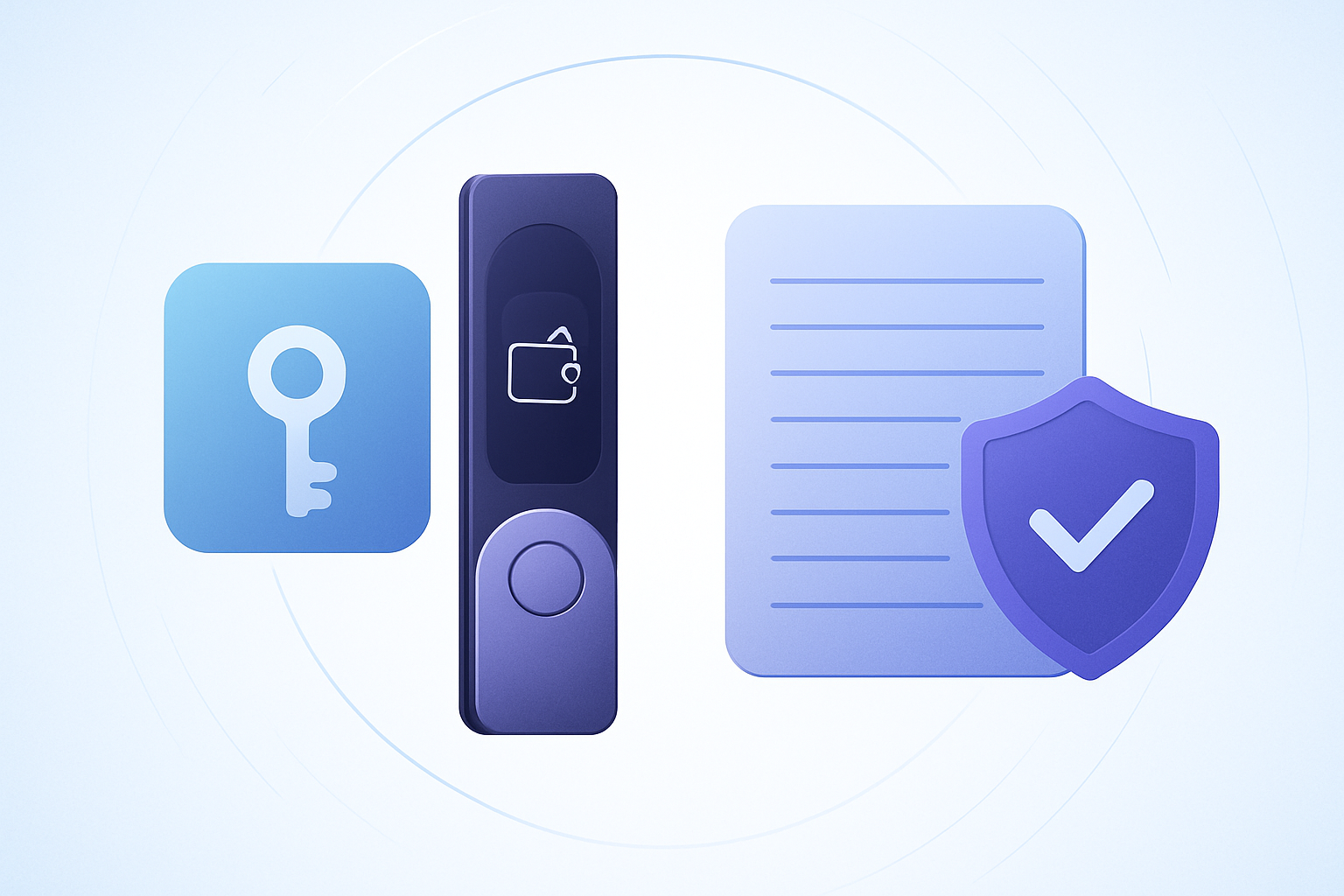Ledger has redefined the hardware wallet game in 2025, dropping not one but two touchscreen titans: the Ledger Flex™ and Ledger Stax™. Both boast secure E Ink® displays and ironclad security, but their visual experience and ergonomic flair are where the real differences pop. If you’re hunting for a crypto wallet touchscreen comparison that focuses on design, usability, and those all-important clear signing moments, you’re in the right place.

Display Showdown: Flat vs Curved E Ink® Screens
The touchscreen is the heart of any modern crypto wallet, dictating not only how you interact with your assets but also how confidently you can review and sign transactions. Let’s break down the visual specs:
- Ledger Stax™: 3.7-inch curved E Ink® touchscreen, 16 grayscale levels, lock screen and spine customization for easy device stacking and quick identification.
- Ledger Flex™: 2.84-inch flat E Ink® touchscreen, 16 grayscale levels, lock screen customization only, with built-in magnets for accessory attachments.
The Stax’s larger, curved display isn’t just for show – it’s a game-changer for users juggling multiple wallets or craving a premium interface. The curved spine lets you label and spot your device instantly, while the Flex keeps things minimal and functional with a compact, flat screen. If you’re all about that tactile, futuristic feel, the Stax takes the crown. But if you want a streamlined, pocketable device, the Flex is tough to beat at its price point.
Security Features: Identical Under the Hood
Let’s address the elephant in the room: Both devices offer Ledger’s industry-leading security. Each is equipped with a CC EAL6 and certified Secure Element chip and runs Ledger’s proprietary OS. That means whether you’re signing a transaction on the Flex or the Stax, your private keys never leave the device and your assets are protected by the same bulletproof technology. For users prioritizing security above all else, you can’t go wrong with either.
Charging and Connectivity: Wireless or Wired?
The charging and connectivity options are where these wallets really start to diverge. The Ledger Stax™ comes loaded with wireless Qi charging, Bluetooth, NFC, and USB-C. That means you can drop it on a wireless pad and forget about cables. The Ledger Flex™, on the other hand, skips wireless charging in favor of a pure USB-C approach – but still offers Bluetooth and NFC for seamless mobile use.
Pros & Cons: Wireless vs Wired Charging for Crypto Wallets
-

Wireless Charging (e.g., Ledger Stax™): Pro: Convenient and cable-free—just place your wallet on a Qi charging pad for easy power-ups, reducing cable clutter.Con: Slower charging speeds compared to wired options, and requires compatible charging pads.
-

Wired Charging (e.g., Ledger Flex™): Pro: Faster and more reliable charging via USB-C, ensuring your device gets a full charge quickly and consistently.Con: Less convenient—requires carrying and connecting a cable, which can add bulk to your setup.
-

Wireless Charging: Pro: Less wear and tear on the device’s charging port, potentially extending hardware lifespan.Con: May not be as widely available in public spaces or while traveling, limiting charging options on the go.
-

Wired Charging: Pro: Universal compatibility—USB-C ports are standard and easy to find, making it simple to charge almost anywhere.Con: Physical connectors can degrade over time with frequent use, possibly requiring repairs or replacements.
If you’re always on the move or hate cable clutter, Stax’s wireless charging is a serious perk. But the Flex’s no-nonsense USB-C keeps things simple and reliable, especially for users who prefer to charge directly from a laptop or power bank.
Visual Customization and Everyday Usability
Customization isn’t just about aesthetics – it’s about making your everyday crypto experience faster and more intuitive. The Stax’s curved screen allows both lock screen and spine customization, so you can quickly identify your device even when it’s stacked with others. The Flex focuses on lock screen personalization, paired with magnetic accessory support for modular upgrades.
This visual distinction is more than skin-deep. For power users or anyone managing multiple wallets, the ability to label and spot your device at a glance is a huge time saver. Meanwhile, the Flex’s minimalist design keeps it ultra-portable and ideal for travel or day-to-day carrying.
If you want to dive deeper into the full visual and security breakdown, check out our detailed guide: Ledger Flex vs Ledger Stax: Visual Guide to Clear Signing and Crypto Security.
Price is always a deciding factor, especially when the security stakes are identical. The Ledger Stax™ retails at $399, positioning itself as the premium pick for those who value a larger display, wireless charging, and that signature curved design. The Ledger Flex™ comes in at a lean $249, making it a compelling choice for users who want next-gen security and a crisp E Ink® touchscreen without splurging on extra bells and whistles.
User Experience: Which Wallet Fits Your Flow?
Let’s talk real-world usage. The Stax’s larger, curved display is a dream for reviewing long addresses or transaction details, think crystal-clear clear signing with zero eye strain. The customizable spine is a subtle, genius touch for anyone managing multiple hardware wallets. Meanwhile, the Flex’s compact form slips easily into a pocket or bag, perfect for on-the-go traders or minimalists who want security without bulk.
Bluetooth, NFC, and USB-C on both devices ensure you’re never stuck fumbling with the wrong cable or struggling to connect to your phone. Whether you’re using an Android, iOS, or desktop, both wallets keep you flexible and future-proof.
Key User Experience Differences: Ledger Flex™ vs Ledger Stax™
-

Display Size & Shape: Ledger Stax™ boasts a 3.7-inch curved E Ink® touchscreen, offering a larger and more immersive interface. Ledger Flex™ features a 2.84-inch flat E Ink® touchscreen for a more compact experience.
-

Customization Options: Stax™ users can personalize both the lock screen and device spine (great for stacking and easy identification). Flex™ allows lock screen customization only, with built-in magnets for accessory attachment.
-

Charging Methods: Stax™ supports wireless Qi charging for cable-free convenience, while Flex™ relies solely on USB-C charging—no wireless option.
-

Portability & Accessories: Flex™ is designed with built-in magnets for attaching accessories, enhancing portability. Stax™ focuses on stackability with its curved design.
-

Price Point: Stax™ is the premium pick at $399, while Flex™ offers a more affordable entry at $249, making it ideal for budget-conscious users.
Which One Should You Choose?
Here’s the bottom line: If you crave a high-end, visually striking crypto wallet with wireless charging and advanced customization, the Ledger Stax™ is worth the $399 investment. It’s built for collectors, power users, and anyone who wants their hardware wallet to double as a showpiece.
If your priority is unbeatable security in a slim, wallet-friendly package, and you’re happy charging via USB-C, the Ledger Flex™ delivers top-tier protection at $249. It’s a no-fuss, all-function device that still packs in all the core features modern crypto holders demand.
No matter which you pick, both wallets support over 5,500 digital assets and stand tall as leaders in the E Ink crypto wallet space. Your private keys stay offline, your transactions are always clear signed, and you get the peace of mind only a true hardware wallet can offer.
Want to see how these wallets look and feel in real life? Check out our full unboxing and hands-on review here: Ledger Flex Unboxing and Review: Is the New Hardware Wallet Worth It for Crypto Security?




